A Closeness To Life
December 4, 2022
Text by Nadine Hanson with Salty Xi Jie Ng
“I think and I propose that collaborative art spaces are semi-fictional worlds because we are birthing into being a kind of relational experience that did not exist before.”
Salty Xi Jie Ng
I was introduced to Salty Xi Jie Ng’s work through my twin brother, Nolan, whose time in the Art & Social Practice program overlapped with Salty’s. I was, and remain, so drawn to the intricate yet inconceivably vast spiritual landscapes that are created and explored in her interdisciplinary practice. In my own work, I’m feeling curious about fantasy as a tool and site of social engagement and performances of the everyday, themes which I see represented in Salty’s projects. We met for the first time via phone; Salty, in Singapore, and me, in my apartment in The Bronx. She was patient and warm as I asked her some questions about her life and art practice, and she shared some of her cosmic wisdom.
Nadine Hanson: Do you have a morning routine?
Salty Xi Jie Ng: I love that question. I think about my morning routine all the time. How can I actually do it better? I wake up and I make my bed, and then I have a customized stretching sequence that I made for myself and what my body needs, although it probably needs updating, and it ends with some qigong and brushing of excess energy from the body and petting the body to awaken it. After that, I will take a quick shower, because it’s hot in the tropics so a shower is necessary every morning and refreshing because it’s very hard for me to get out of the hypnagogic sleep state. After that, I’ll make breakfast which is usually fruit, oats and an egg. So that’s the morning routine.
Nadine: Where do you feel the most calm?
Salty: When I’m with a bodyworker or therapist I trust, or in the arms of my partner when we cuddle, or a moment of meditation where I reach a sense of spaciousness.
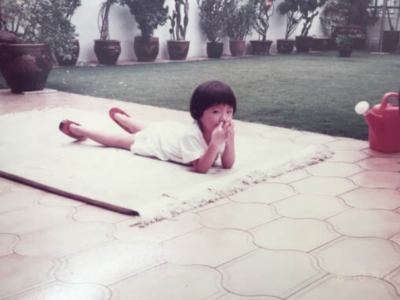
Image courtesy of Salty Xie Jie Ng
Nadine: What is your favorite piece of clothing?
Salty: There are too many pieces of clothing that I feel attached to. When sorting through my life’s possessions recently, I found about 50 pairs of old, saggy, crunchy underwear I’d kept since teenagehood. I kept some to make a shawl of my teenage girlhood.
Nadine: Do you identify as a social practice artist?
Salty: I identify as an artist who makes a whole spectrum of work, including social practice, performance, film, installation, writing, movement, and so on. I think it’s important to be as expansive as one can be because there’s many ways to express oneself for different seasons of our lives. Working relationally is just one approach or one tool that I might have, one response to a context. I’m at a time where I really want to allow myself to be, and be seen as a whole spectrum of things.
Nadine: How do you explain social practice to non artists?
Salty: Art that is made in collaboration with other people, that is not focused on making objects, where the shared experience is the art itself. I think the ways that shared spaces in socially engaged art projects unfold can be very mysterious and alchemical, even if there’s a methodology and a lesson plan. I think about how all the energies of people and their histories intersect, and how we change each other through the ways that we spend time together in those spaces—there’s something very cosmic about that. The work makes you as much as you make the work.
Nadine: Could you tell me a little bit about what draws you to making work on the subject of intimacy?
Salty: In my life, outside of artistic practice, I’ve always been drawn to intimacy: I’ve always wanted to come closer to life in any way that I could, to the sense of being alive and uncovering things. I remember feeling that from the time when I was a child. Now, I think of much of my work as creating spaces for intimacy. In The Grandma Reporter issues 2 and 3, I investigated the subject of intimacy with senior women in Portland and Singapore. Now I’m thinking a lot about eroticism—also a closeness to life, a sister to intimacy which vibrates at another tone.
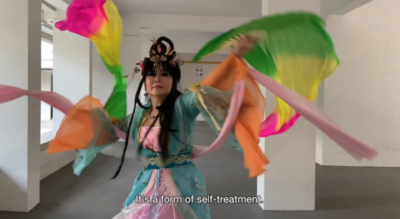
Image courtesy of Salty Xie Jie Ng
Nadine: In your project “Not Grey: Intimacy, Ageing, & Being,” Zubee Ali describes her first love affair with a woman and says: “she introduced me to love– being able to love another and allowing myself to be loved.” In your experience, how can one allow oneself to be loved?
Salty: By first learning to love oneself and then saying to the universe, let me be loved– by the sun, the sky, the moon, the wind, the waters, and then, maybe, by someone. But know it will most likely bring a good amount of pain! You must be ready. Often you have no choice; it will come even when you are not ready.
Nadine: Have you ever been in love?
Salty: Oh many times. Always, forever.
Nadine: Do you think that part of love is fantasy?
Salty: Part of it, yes. I think that when we start loving something, there’s always a sense of projection– a sheath of fantasy– around it, whether that thing is a person, a subject, a theme, an animal, an idea. I’m very interested in that sheath of fantasy, in the space of the semi-fictional. As you love something longer, you come, perhaps, to painful truths about that thing, which are necessary to experience.
Nadine: Could you articulate how you interact with fantasy?
Salty: I think and I propose that collaborative art spaces are semi-fictional worlds because we are birthing into being a kind of relational experience that did not exist before. Just by sharing space in the ways we do, we are making a future we want to see and be in. In that space of semi-fiction, new ways of being and being together land softly; new visions of life coalesce like rain clouds, new truths emerge. Fiction and reality cannot do that alone.
Nadine: What has performance allowed you to do in your work?
Salty: Performance takes me to an altered and heightened state of being, where I think performers channel and access different energies.
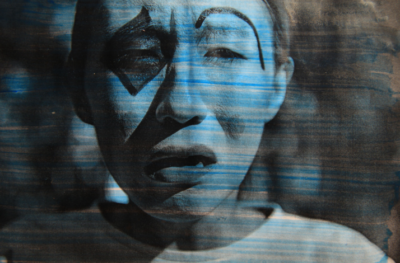
made on residency at Arteles Creative Center, Finland, 2014
Image courtesy of Salty Xie Jie Ng
Nadine: What do you think those energies are?
Salty: [laughs] What a metaphysical question. Energies from other realms and dimensions, energies from nonlinear time and space. Whether consciously or unconsciously, performers access myths, messages from other entities, histories of a place, and more. An entire field is speaking to them.
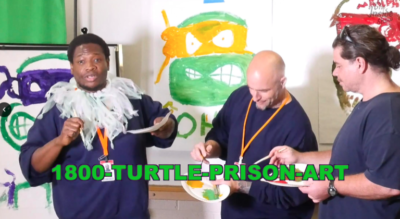
Nadine: What have you been up to since you’ve graduated?
Salty: I made The Inside Show in collaboration with inmates at Columbia River Correctional Institution. I got a job as artist-in-residence in 2019 and 2020 at the University of Massachusetts, Dartmouth, where I made Words of Support, Faculty Relations, A Whaling Descendant Performs In Four Acts, and The Alternative Moby-Dick Marathon. When the pandemic hit, I came back to Singapore and really struggled with mental health. For five months as the artist-in-residence of a Singaporean mall, I ran Buangkok Mall Life Club, a retail unit turned art space. Then, among other projects, I worked on Not Grey: Intimacy, Ageing, and Being, STREET FOUND, and Dear Singapore Art Museum Acquisition Committee, from which emerged my curator persona Sheralynne Dollatella-Wong Jia (MA Curation, MA Arts Business). She challenges museum practices, specifically around acquisition. It was a response to being part of the international contemporary art world while feeling disturbed by the way it operates. Recently, Sheralynne worked with the Museum Why network in Scandinavia for their symposium rethinking museums.
Somewhere in there, my paternal grandma, whom I’m very close to, passed away. Soon after, I began a residency at the Singapore Art Museum. I spent my time there processing the early stages of grief, from which emerged Baibai Research Group, a growing body of work on expanded spiritual expressions stemming from Chinese ancestor worship, the spiritual lineage I carry. There is learning about syncretic Chinese religious practices in Singapore, grieving in public, working with non-human collaborators, and being able to connect with people around my generation in Singapore on a subject we don’t quite engage with together. It’s a beautiful opportunity to re-imagine the ritual practices I grew up with.
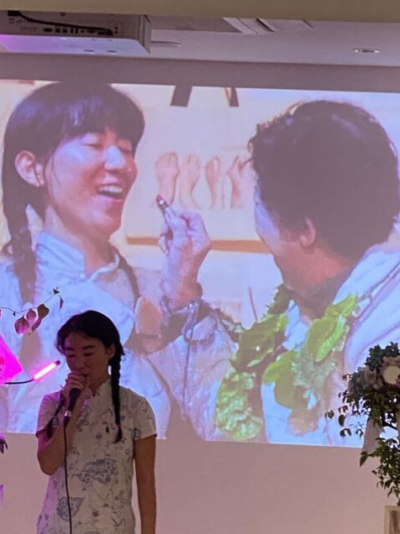
Singapore Art Museum / Singapore Art Week, 2021-22
Image courtesy of Salty Xie Jie Ng
That was a lot! Currently, I’m taking a pause to re-envision my practice. My friends could not believe that I would have no projects lined up, because I’ve been going nonstop for so many years but I think that recalibrating is so important. Life can be so many ways. I’ve been on a quest to sort through my entire life’s possessions. Given I’m a hoarder, this has been a mammoth task. I’m determined to finish because I think it will create the space to re-envision and make space for new things to enter my life. It’s already happening.
Pausing on big projects has also been about detangling my sense of self-worth from the work I have lined up, or lack thereof. People don’t talk much about the toxic culture of production and competition perpetuated by hegemonic art world forces. I want to live in a world where artists’ creative gifts can be honored and met by the world in healthy, sustainable ways.
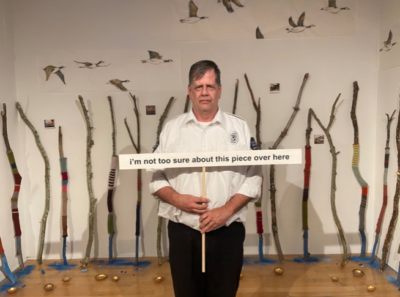
Nadine: Ritual has come up in your work, and in an interview about your recent project, “Baibai Research Group,” you talk about “ritual as wish fulfillment.” Would you be able to share some wishes that you’ve fulfilled (or hope to fulfill) through ritual?
Salty: My paternal grandmother’s safe passage to the next realm, which can be prayed for through certain prescribed rituals, or rituals one can invent. The ability to communicate with departed loved ones just by being in a space of ritual. Contributing towards them having an ample and interesting afterlife— in Chinese ancestor worship, paper effigies are burnt to send gifts to the other realm; for example, a dog to annoy my paternal grandma since she hates dogs, and a vespa and cigarettes for my paternal grandfather. The releasing of old traumas or stuck feelings, while meeting selves or a renewed self that can come through performance— ritual is performance.
Nadine: Do you have any advice for how to care for oneself while making socially engaged work?
Salty: Here are some thoughts, and I’m telling this to myself as much as sharing with you. Establish healthy boundaries around communication via text and email. Take at least one day off a week where you don’t work or think about it (try!). Be able to envision, as much as possible, the many kinds of labor involved so you can pay yourself appropriately, or expand the team and learn to share, outsource, delegate, trust. I am a big empath and easily affected by the energies of others. By the end of the day, I always shower, stretch and do some qigong exercises to release excess energy. Spending time alone is really important. Part of that time can be spent reflecting on what part of the work brings you joy and curiosity, and how to keep connecting with that while a project unfolds.
Salty Xi Jie Ng (she/her) co-creates semi-fictional paradigms for the real and imagined lives of humans within the poetics of the interdimensional intimate vernacular. Often playing with relational possibilities, her transdisciplinary work is manifested from fantasy scores for the present and future that propose a collective re-imagining through humour, care, subversion, play, discomfort, a celebration of the eccentric, and a commitment to the deeply personal. Her practice dances across forms such as brief encounter, collaborative space, variety show, poem, conversation, meal, publication, film, performance.
Nadine Hanson (she/her) is an artist based in New York City who, for the last decade, has worked service-industry positions in bars, restaurants, hotels, and other people’s homes. Her occupational experience informs her interdisciplinary practice, which uses collaborative approaches to performance, writing, and experimental documentary to explore commonly under-valued and feminized knowledge bases and forms of labor.


